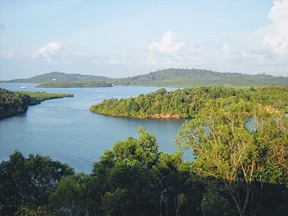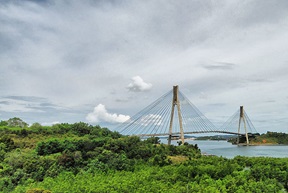We know that fossil and nuclear energy, and mining of resources, can have most unwanted social effects on local communities. Now this appears to be true for solar projects as well. As is testified to by a Chinese plan for mining resources for a solar panel industry on the Indonesian island of Rempang, just off the coast of Singapore.

An article on The Conversation by Nikita Sud, professor at the University of Oxford, drew our attention. Her conclusion is that ‘the transition to green energy, far from creating a green new deal for all, is actually reinforcing entrenched inequalities and hierarchies.’ How come, and what shape does this take?
‘A state-backed land grab’
Sud’s first visit to the area was uneventful. But a year later, the island was in turmoil. People protested because the island’s 16 villages and 7,500 inhabitants were to be evicted. ‘The Indonesian government and a Chinese-backed business consortium want to move the entire community to another island and turn their home into a huge solar panel manufacturing centre, solar farm, and ‘ecocity’.’
This is quite similar to the preparation of mining projects. There too, villages are being evicted, people relocated, before the major project can start. But why on this island? Why don’t the industrial activities match with traditional village life? And why did things move so fast?
Chinese investors
From April 2023, news came in that a well-connected businessman from Jakarta was to build a ‘township’ on Rempang. A Chinese ‘glass manufacturer’ was also supposed to be involved. The project was backed by the authorities, up to the central government in Jakarta. And the project will be huge. It will displace 16 villages on Rempang island and will even cover 17,000 hectares of land.

Residents petitioned different layers of government, sought meetings, and even went to Jakarta to try and meet officials. But to no avail. By the last week of August 2023, there were demonstrations: in Rempang and Batam, and even in Jakarta. Despite growing opposition, authorities dismissed popular discontent as ‘miscommunication’. By the last week of August, there were demonstrations at various locations in Rempang and Batam. Hundreds of people protested in central Jakarta on September 20, 2023. Local and international media, which had initially ignored the Rempang issue, was finally covering it amid escalating ‘rioting’ at Rempang.
Towards ‘green’ Rempang
Plans for development of the island date back to 2004. Back then, the intention was to create a tourism zone. But now, industry has been added to the development goal. The world’s largest manufacturer of glass and solar panels, China’s Xinyi Glass stepped into the project. It intends to construct a mega factory, producing solar panels, the money maker of the near future. The company intends to invest as much as US$ 11.6 billion for the factory over several decades. It seems that in return they have been promised Rempang’s land. And it seems there is no place for the existing community in the futuristic vision of ‘green’ Rempang.
What does the island have to offer to the investors? Young and cheap labour; natural resources like silica, nickel and cobalt. And not surprisingly, Indonesia’s willingness for regulatory flexibility. The government declared the Rempang project to be a Project of National Strategic Importance, allowing it to bypass social and environmental impact assessments, and acquire land quickly. Over the past few years, China invested heavily in Indonesian infrastructure; the Rempang project may be just ‘in return’.
Strategic importance
Probably, China is trying to reinforce its position in the booming solar market. Already, China produces three quarters of the world’s solar panels. And even 97% of the solar wafers that are at the heart of this technology. Much of this in the remote areas of Inner Mongolia and Xinjiang – regions with poor human rights records. The EU and the US try to recover their share of the industry with policy measures like subsidies and heavy import taxes. Maybe China tries to circumvent such policies by creating solar panel factories in ‘neutral’ countries like Indonesia.
Moreover, Indonesia has large deposits of critical metals, required for solar panel and wind turbine construction, like cobalt, lithium and nickel. They are not located in Rempang. But the island has another resource, critical for solar panel construction: sand. Until recently, sand was mined in this region for construction purposes: to allow the enlargement of Singapore. Now, the wafer industry needs the silicon from the sand. Unfortunately, mining sand will muddle the waters around the islands and reduce the number of fish.
A priority project
The ecocity and solar panel project are a priority for the government of Indonesia. Ministers have come to the island in order to convince local citizens. Eviction was planned for September 28, 2023. At a very late stage, the government also proposed compensation, to the amount of $ 7760. Still, this amount paid to all citizens would constitute just 0.3% of the total cost of the project.
Reactions to relocation proposals are mixed. Some inhabitants seem to be willing to accept the money and leave. Some want a higher compensation. But many don’t want to leave. Protests have forced the government to postpone the eviction date. Some changes on the relocation circulate. But as a whole, plans remain intact. So, residents are asking fundamental questions like: where will our children study? And, will the solar panel factory displace ancestral graves?
Conflicts over the relocation plan have long gone unnoticed. There are always conflicts over resources and land in Indonesia. But from September 2023 onwards, civil society groups have become aware of the Rempang struggle and stepped in.
Let’s not look the other way
Conflicts have popped up at all places where colonial powers saw an opportunity to exploit other country’s riches. What’s new in this case, is the identity of the colonial power (China) and the object of the colonial plans (a factory of solar panels). Let’s not be mistaken: also in the solar revolution, of which we are in the middle, there will be losers. Particularly in remote areas of the planet. That shouldn’t prevent us from having a keen eye on negative consequences of projects; even of they have the benefit of mankind as a goal.
Also check:
https://edition.cnn.com/2023/09/19/asia/indonesia-rempang-island-protests-chinese-factory-intl-hnk/index.html
https://bnn.network/world/africa/indonesias-rempang-island-a-microcosm-of-the-global-green-energy-debate/
https://www.straitstimes.com/asia/se-asia/rempang-land-dispute-casts-new-spotlight-on-old-complaints-over-chinese-investments-in-indonesia
Interesting? Then also read:
Geopolitics of phosphate in a biobased economy
NGOs challenge Chinese mega investment in Canadian tar sands
Mining bio-ore for nickel
